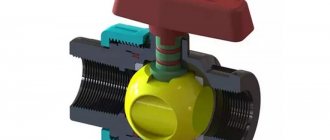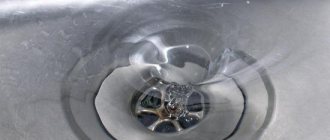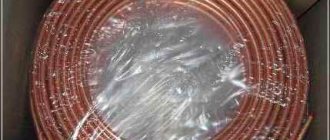What is the difference between heating pipes made of different materials? What are the features of connections and what else should you pay attention to when choosing?
The heating boiler has been selected and purchased, you can begin to supply heat to the house. But how to choose the right pipes for your heating system? The situation is approximately the same as with boilers: manufacturers praise their products, and in stores they try to sell what is more expensive. On the Internet, opinions vary even more.
There are no downright bad pipes. Each technology has its pros and cons, and the quality of the entire pipeline depends on the correct combination of pipe material and the method of their connection.
What is a water supply network
The water supply network of a building is the water supply system that distributes water to consumers. The first rule that we need to pay attention to tells us that the water supply network should be minimal in length. As a result, water supply pipes are laid along the shortest routes. The second rule states that the pressure in the water supply system inside the building is limited to an upper threshold of 0.6 MPa.
There are three main elements of any building plumbing:
- Mains : supply water to the network risers;
- Risers : deliver water to the floors;
- Distribution : water distribution to consumers on the floor (apartment).
There are ring and dead-end water supply networks. The first is done only with lower wiring. The second is done with lower and upper water distribution.
The lower wiring is done from the highways laid at the bottom of the building (basement, under the floor of the 1st floor).
The upper distribution of pipes is done from the mains laid along the top of the building (attic, ceiling of the upper floor). Most often, this scheme is used in buildings with water tanks. The disadvantages of this scheme are the increased length of the water supply system, the increased danger of upper flooding and the mandatory insulation of the attic.
In apartment buildings with a large number of water distribution devices, a scheme of vertical mains (risers) is used with pipes routed to consumers along the horizon.
Stub networks are given priority. However, in buildings above seventeen floors, buildings from nine to twelve floors, vertical ringing of risers is used to reduce hydraulic resistance.
How to clean a pipe yourself if you couldn’t find the blockage
There are several ways to clean water supply lines at home:
- Turn on the water in all taps and carefully tap the communications along the entire length. If water with rust or dirt comes out of the tap, the action can be repeated several times. At the same time, rust, sand, and salt deposits fly off from the walls inside the pipe. The flow of water under pressure washes contaminants out of the pipeline.
- Household chemicals. To do this, a steel pipe cleaner is poured into the water supply lines. Access to all household appliances is first blocked to prevent aggressive chemicals from getting inside. Leave the solution for 2-3 hours. Then rinse with plenty of water, opening the pressure to full power. This method of cleaning water pipes is controversial because it can pose a danger to humans if household chemicals are retained inside the communications.
- Mechanical cleaning yourself using a special cable. For such cleaning, the pipes are dismantled. Using a plumbing cable, the “insides” of the water supply section are carefully passed several times. The rigid brush of the cable effectively cleans the inside of the water supply system, removing rust, scale, sand and salt deposits from the walls. At the end of the procedure, the communications are connected and washed.
There is a method of cleaning a water pipe called hydro-jet. Its essence is that the dismantled pipe is connected to a high-pressure hose and the blockage is broken through with water pressure. However, this method cannot be used for home use.
Note! All of the above methods for cleaning a water supply with your own hands are applicable only to new communications. Pipelines with a long service life have a significant degree of wear. Using force or chemical cleaning methods can completely destroy them.
Water pipes inside a building
Obviously, pipes are the most important element of the water supply system inside a building. According to general characteristics, water pipes should:
- Withstand the pressure of the water supply network;
- Skip the calculated water flow;
- Serve for 10 years;
- Have a smooth inner surface, which minimizes the hydraulic resistance of the pipe;
- Do not degrade water quality;
- Be convenient for carrying and installation.
According to the standards for internal water supply, pipes are produced from the following materials:
Steel
Steel pipes made of ferrous and galvanized metal (GOST 3262-75) are distinguished by high strength, reliable welded or threaded connections, and do not require additional protection from mechanical damage.
For installation inside buildings, water and gas pipes are used, which are marked as ordinary and light, with nominal diameters from 10 to 150 mm, designed for a pressure of 1 MPa. Or electric welded pipes with a diameter from 65 mm to 50 cm, for pressure up to 1.6 MPa. Pipe lengths range from 4 to 7 meters. Galvanized steel pipes thicker than 150 mm are not produced.
Various types of plastic
Pipes made of plastics have the advantage of lighter weight, lower hydraulic resistance and the highest resistance to corrosion. However, plastic pipes do not withstand impacts, strong bends and expand from hot water. These circumstances must be taken into account when designing and installing water supply inside the building.
According to existing standards for domestic water supply networks, the use of:
- Polyethylene pipes PE, GOST-18599-2001 D=20÷800 mm. Including pressure pipes HDPE pipes (low pressure polyethylene). Imported PE marking.
- Pipes made of cross-linked polyethylene (PEX), GOST 32415-2013. Due to low thermal expansion, they are used for hot water supply (DHW).
- Metal-plastic pipes (GOST R 53630-2015). By design, it is a polyethylene pipe with an internal frame made of copper or aluminum foil. Used for both cold and hot water supply.
Cast iron, pressure asbestos, and glass pipes are NOT used for water supply inside buildings.
Home methods for cleaning pipes
The whole process consists of the following steps:
- Determining the location of the blockage.
- Disconnecting the apartment from the centralized system.
- Clearing the blockage.
- Installation of the system with connection.
You can block the entrance yourself. But if there is no valve, you will have to look for a plumber to shut off the entire riser. The technology for cleaning water pipes from deposits varies depending on the causes and symptoms:
- The pressure is not enough for normal operation of household appliances (dishwasher and washing machine, boiler or geyser). It is necessary to unscrew the mesh filters, replace them or clean them with a brush.
- The pressure dropped at all taps and consumers. The main input and filters of the water purification system are checked. It is possible to replace them or treat them with special compounds that corrode salt and lime deposits.
- The stream in one of the mixers has weakened. You need to remove it and clean the mesh filter. There is no point in asking faucets to work properly after 5 years. Once every five years this element must be replaced.
- Water does not flow to any of the consumers, but there is no problem at the inlet. This is the most difficult case, when you will have to disassemble the system completely and clean the pipes in stages until the blockage is cleared.
In the latter case, it is extremely difficult to determine exactly where the system is impassable. Therefore, you need to focus not on the symptoms, and take other measures to clean the water pipes with your own hands. If the procedure initially seems complicated and impossible, you should immediately contact professional plumbers.
Internal water pipe connections
Installation of a water supply system involves connecting and branching pipes. Technologically, permanent and detachable connections of water pipes are provided.
The permanent connection is made by welding. Steel pipes are welded using gas or electric arc welding. Polyethylene pipes are butt welded or through a coupling. Permanent connections also include raster pipe connections (using glue or welding) and pipe connections by pressing.
The detachable connection of pipes is carried out using a coupling thread (for steel pipes) or a clamp fitting (collet) for polyethylene pipes. The main disadvantage of threaded connections is the possibility of leaks, which results in undesirable concealment of such a water supply system.
The fittings are connected to pipes using flanged or threaded connections. In apartments and private houses, flange connections are not used.
Causes of clogged pipes
The main reason is growths on the inner surface of the pipe. This is especially true in older houses. There is no sharp drop in pressure observed. This is a long process, but after a certain point the pressure becomes insufficient. As a result, the washing machine, boiler or water heater cannot function normally.
A sharp drop in pressure is due to one of the reasons:
- The formation of limestone deposits, which is introduced into the water by municipal services at the DFS as an antiseptic.
- Corrosion. Rust that forms in pipes can grow to the point that it blocks the flow of water.
- Natural salts. This refers to the natural impurities contained in water, even if it comes from a well or borehole.
- Breakdown of the filtration station. Suspended solids entering the system accumulate in bends, fittings, valves, etc.
The result is always the same - lack of pipe capacity, decreased pressure, lack of pressure. However, there are methods that allow you to clean it yourself.
Routing plumbing in a building
Laying, or routing of the water supply network is carried out along the shortest paths with minimal intersection of routes and building structures.
The routing of the water supply network inside the building is done while maintaining parallelism to the lines of the columns, walls (vertical) and floor (horizontal).
The water pipeline can be laid openly or hidden.
Open water supply , this is a water supply system whose pipes are visible visually, is called open. There are no restrictions on the methods of connecting open water supply pipes.
Hidden water supply inside the building is laid in the walls and/or floor (screed). For hidden water supply systems, only welded pipe connections are allowed, excluding the connection points for appliances. In places where shut-off valves are installed for hidden water supply systems, hatches must be provided. Read Hidden water supply of the apartment
Embryology
Rice.
1. Schematic representation of some stages of development of the fallopian tubes: a - in an embryo of 8-9 weeks, paramesonephric canals are formed (1) - the material of the future fallopian tubes and mesonephric canals (2) of the primary kidney; b - in a fetus of 22 weeks, the muscular (5) and connective tissue (4) layers of the walls of the fallopian tubes are formed; longitudinal folds (3) of the mucous membrane are pronounced; c — in a 28-week fetus, the folds (3) of the mucous membrane increase; d - in a newborn, folds (3) of the mucous membrane are complex tree-like formations; The folding of the mucous membrane increases during the formation of the fallopian tubes. In embryos 8–9 mm in length, at the cranial part of the primary kidney above the gonad anlage, a symmetrical invagination of the coelomic epithelium into the mesenchyme occurs at the level of the first thoracic vertebra. These areas form blind tubes that grow along the ducts of the primary kidney, forming paramesonephric (Müllerian) canals (Fig. 1a); the cells of the epithelium lining them acquire an elongated shape, and the epithelium subsequently becomes pseudostratified. The paramesonephric canals (ducts, T.) run parallel to the ducts of the primary kidney on the lateral side and somewhat outside of them and open into the cloaca with separate openings. At the opposite end, the channel ends in a blind extension. This end continues to grow and then becomes lumen. The uterus, fallopian tubes and upper part of the vagina develop from the paramesonephric canals; The fallopian tubes are formed from the upper third of the paramesonephric canals. Within 11-12 weeks. During intrauterine development, the muscle and connective tissue layers of their wall are formed from the accumulations of mesenchyme around these canals. All structural elements of the fallopian tube wall are clearly visible at 18–22 weeks. intrauterine development; during this period, the longitudinal folds of the mucous membrane are already well defined (Fig. 1, b). By 28 weeks the folds increase, and in a newborn girl the mucous membrane of the M. t. is already represented by tree-like formations, the epithelium is single-layered with a prismatic shape (Fig. 1, c, d). The first cilia on the epithelial cells of the tubal fimbriae appear at 16 weeks. intrauterine development. The epithelial layer of the mucous membrane of the t. reaches its maximum development at 30-31 weeks. intrauterine development. The muscular layer of the uterus develops simultaneously with the muscular layer of the uterus from the mesenchyme surrounding the paramesonephric canal. Circular and then longitudinal muscle layers are formed by the 26-27th week. Vessels develop in the outer connective tissue layer; later this layer decreases in volume. The left tube (like the ovary) develops somewhat later.
Age characteristics
By the time a girl is born, the formation of the Fallopian tubes is anatomically largely completed; the tubes look like convoluted tubes about 3 cm long. Histologically, three membranes are formed, but the mucous membrane is not yet mature, the differentiation of its components is not complete. In the muscular layer, the formation of the outer longitudinal layer has not yet been completed. In the isthmus of the bladder, 4-5 low primary folds can be noted; along the length of the tube towards the ampulla, the folds become higher and densely branch. The height of the epithelial cells increases towards the abdominal opening of the M. t.; there are especially many tall cylindrical cells with narrow elongated nuclei and single ciliated cilia, often glued together. Secretory large cells with lighter nuclei are more often found at the base of the primary folds, while at the top of the folds they are single. In low, small cells with large nuclei and light vesicular cytoplasm, figures of mitotic divisions (cambial elements) are found. Connective tissue is formed by delicate collagen fibers and a large number of cellular elements, rich in CHIC-positive substances and acidic mucopolysaccharides. Subsequently, especially during puberty, M. t., like all parts of the reproductive system, increase significantly, although under unfavorable conditions the infantile type of M. t. can persist in an adult girl and woman.
Video description
The video describes in detail what markings polypropylene products have and how plastic pipes are installed and soldered:
Polyethylene pipes
They are made from polymerized ethylene and have all the advantages of plastic pipes, but they have one distinctive feature - high plasticity. Products are sold in rolls. Using them, you can construct engineering communications of complex shapes. They cannot transport hot water (it softens the polyethylene, which can cause the line to rupture). Low-pressure polyethylene pipes (LDPE) are ideal for assembling drinking water supply systems; water in them can be transported under a pressure of no higher than 10 atmospheres.
Roll of polyethylene products Source i4.photo.2gis.com
What is tubal obstruction
The content of the article
Obstruction (blockage) of the fallopian tubes is one of the main causes of female infertility, in which sperm moving into the tube through the uterus cannot reach the egg to fertilize it. And if conception does occur, the large embryo does not enter the uterine cavity. In this case, a tubal (ectopic) pregnancy occurs, which is life-threatening for the woman.
For various reasons, adhesions form in pipes - dense fibers and films that glue tissues located next to each other. The resulting compaction causes obstruction of the fallopian tubes to varying degrees.
Surgical procedures that cause tubal obstruction
Medical manipulations, or rather their consequences, which negatively affect the functionality of the appendages:
- Curettage (removal of the fetus by curettage, an undesirable consequence - inflammation or infection)
- Diagnostic uterine curettage (removal of the endometrial layer inside the uterus);
- Failed IVF;
- Incorrectly installed intrauterine device (injures the wall of the organ, provokes infection);
- Difficult childbirth.
Surgery often leads to complications that cause problems with women's health. After surgery, the risk of the following diseases increases:
- Myomectomy (removal of fibroids from the muscular layer of the uterus);
- Tubotomy (laparoscopic surgery on the fallopian tubes);
- Cystectomy (removal of a tumor inside the ovary);
- Appendectomy (emergency surgery on the appendix);
- Treatment of ruptured ovarian cyst.
If complex operations on female organs are rare, then every second woman undergoes abortions and curettage. Even if the termination of pregnancy was completed without complications, small fragments of embryonic tissue may remain in the uterus. The decomposition of residues causes inflammation of the organ, which... It spreads to the fallopian tubes. If urgent measures are not taken, the areas of inflammation will heal and become hard and inelastic.
In some cases, hydrosalpinx is formed - a benign neoplasm with serous fluid inside, which blocks the lumen of the tube, preventing pregnancy. After removal of the hydrosalpinx, the lumen of the appendage increases, but the fimbriae can no longer function normally. Infertility occurs, which is not treated conservatively.
Physiology
The activity of the Fallopian tubes is related to the age and functional state of the female body. Functional changes in M.t. are carried out ch. arr. under the influence of neurohumoral regulation (see). Thus, the dependence of the structural and functional state of epithelial cells of the mucous membrane on the hormonal status of the body has been established. Experiments have established that castration causes partial and complete destruction of the cilia of ciliated cells and flattening of their surface, and with the introduction of sex hormones, the structure of the cells is restored. Contractions of the muscles of the uterus and the type of contractile activity of the organ are not the same in different phases of the menstrual cycle. Three main types of muscle contractions can be distinguished. During the proliferation phase, the excitability of the muscles of the muscle is increased, there is a tendency to long-term spastic contractions with a simultaneous change in the shape and position of the muscle relative to the ovary with elevation of the ampulla and abduction towards the free end; Such contractions of M. t. provide a mechanism for perceiving the egg. During the secretory phase, the tone and excitability of the muscles of the musculoskeletal system are reduced, and contractions become peristaltic in nature. Different departments of M. t. are reduced autonomously and asynchronously. The most pronounced contractions are in the isthmus of the M. t. In the ampulla of the M. t. only pendulum-like movements occur.
Rice. 4. Schematic representation of the fertilization of the egg in the lumen of the fallopian tube and the advancement of the embryo (in different stages of crushing) to the uterus: 1 - fallopian tube with the embryo; 2 - uterine cavity; 3 - ovary with eggs in different stages of maturation; 4 - egg; arrows indicate the direction of movement of the embryo.
The direction of the wave of M. t. contractions is associated with the place of application of irritation (egg, sperm); they can be directed from the ampoule to the uterus (properistalsis) and from the uterus to the uterus (antiperistalsis); these contractions ensure the movement of the egg or embryo into the uterus. When the longitudinal muscles contract, the muscles become shortened; when the circular muscles contract, their lumen narrows. A decrease in the muscle tone of the isthmus of the uterus, which facilitates the passage of the zygote into the uterus, can occur under the influence of prostaglandin E2 contained in the seminal fluid that has entered the woman’s genital tract. If the content of estrogen is insufficient (see), the excitability of M. of t. is reduced, reactions to irritation are weakened, as a result of which the mechanism of perception of the egg may not arise; it may also not arise due to the inhibitory influence of unfavorable psychosexual influences. Fertilization of the egg usually occurs in the ampulla of the endosalpinx. The movement of the egg, zygote and embryo into the uterus occurs primarily as a result of contraction of the muscles of the uterus, as well as the ciliated movements of the cilia of the epithelial cells of the endosalpinx, which are directed towards the uterus in the second phase of the menstrual cycle (Fig. . 4). With the onset of menopause (see), the tone of the muscle membrane of the muscle tissue decreases sharply, the excitability of the muscles almost completely disappears, and there are no contractions of the muscle tissue, except for the ampoule.
The histological structure of M. t. also undergoes pronounced changes in different phases of the menstrual cycle. The height of the epithelial cells of the mucous membrane of the t. is minimal during menstrual bleeding, and at the time of ovulation it is maximum. During the proliferation phase, the number of ciliated and secretory cells increases. The nuclei of ciliated epithelial cells shift upward. In the second phase of the menstrual cycle, secretory cells acquire a goblet or pear-shaped shape and protrude above the ciliated cells due to a simultaneous decrease in the height of the ciliated cells. During this same phase, the number of basal and peg-shaped cells increases. The nuclei of ciliated cells acquire an elongated shape and move downwards. The secretory activity of epithelial cells becomes maximum; the secretion they produce provides the necessary conditions for fertilization and development of the egg in the first days of pregnancy (see). During the proliferation phase, the activity of alkaline phosphatase in secretory and ciliated cells increases, the content of RNA and protein compounds increases; During the secretory phase, the activity of acid phosphatase increases. Such changes can be considered as a consequence of an increase in the intensity of metabolic processes in epithelial cells in the first phase of the menstrual cycle and destructive changes in the second phase. In the uterine part of M. t. histochemical, changes in different phases of the menstrual cycle are much less pronounced. The lumen of the M. t. constantly contains a certain amount of fluid containing glycoproteins, as well as prostaglandin F2α (see Prostaglandins).
Pathology
Developmental defects
Developmental defects are rare and are mainly caused by disturbances during embryonic development. The fallopian tubes may be excessively long or short. There may also be additional openings in the area of the distal end and additional M. t. in the form of small polypous formations with a cavity in the center, which are connected by a thin stalk to the funnel of the M. t. or to the surface of the broad ligament of the uterus. There may be splitting of the lumen of the pipe, lack of lumen in some areas, as well as additional straight, non-branching, blind passages. Less common is complete doubling of the tube. Splitting of the tube, as a rule, is combined with the presence of additional fimbriae, additional side holes on the ampulla, cysts, etc. As a rule, malformations of M. t. do not require treatment.
Disturbances in the contractile activity of the fallopian tubes and disturbances in the advancement of the egg and embryo can result from mechanical obstacles in the form of adhesions in the lumen of the organ resulting from the inflammatory process after artificial termination of pregnancy, as well as neuroendocrine disorders in the woman’s body. Through M. t. during abortion, menstruation, endometrial particles can be thrown into the abdominal cavity, which can lead to the so-called. endometrioid heterotopia. It is possible for tumor cells to move from the abdominal cavity through the M. t. into the uterus, and from it into the vagina.
Tubal pregnancy can occur as a result of implantation and development of the embryo in the mast, followed by its rupture. Tubal pregnancy and rupture
M. t. have a pronounced wedge, picture (see Ectopic pregnancy).
Diseases
Inflammatory diseases of the Fallopian tubes most often occur in the form of salpingitis, which is usually caused by staphylococcus, streptococcus, gonococcus, Escherichia coli, and Mycobacterium tuberculosis. At the same time, gonorrheal salpingitis always develops in an ascending way, staphylococci and streptococci also penetrate into M. t. in an ascending way, and tuberculous lesions of M. t. develop when the infection spreads hematogenously from the lungs, lymphogenously - from bronchial and mesenteric lymph nodes, from the peritoneum . Sometimes infectious agents spread from the appendix and sigmoid colon. Inflammatory disease of M. t. is rarely isolated, usually the ovaries are involved in the process (see); in such cases, the diseases are combined under the term “adnexitis”. Salpingitis usually begins with inflammation of the mucous membrane of the t. and quickly spreads to the muscular layer of the wall and peritoneal cover. The result of inflammation (initially catarrhal, which, however, can become purulent) is obliteration of either the entire uterus or its uterine part and ampulla, which causes persistent infertility (see); accumulation of exudate leads to the formation of sactosalpinx (hydrosalpinx, hematosalpinx, pyosalpinx). Wedge, picture, treatment, prevention - see Adnexitis.
As a result of the inflammatory process, especially with gonorrhea, polyps can form in the lumen of the tumor, which in some cases undergo malignancy and are considered a precancerous process.
Tumors
Fallopian tube tumors are rare. Benign tumors (fibroids, lymphangioma, polyps, lipoma) are detected very rarely; chondrofibroma, dermoid and teratoma are described casuistically. Usually they do not reach large sizes, are not clinically detected and are detected only during operations on the pelvic organs. The frequency of damage to M. by malignant tumors does not exceed 1% in relation to all malignant tumors of the female genital organs. Among malignant tumors of M. t. in the first place is cancer, first described by EG Orthmann in 1886, and in the domestic literature by S. D. Mikhnov (1891). Sarcoma is rare and even less common is chorionepithelioma (the result of a tubal pregnancy). The role of inflammatory processes as an etiol factor in the development of M. t. cancer is doubtful, although the malignancy of polyps, especially those arising from gonorrhea, is beyond doubt. The age of patients with breast cancer is predominantly 40-50 years, and approximately half of those with cancer were infertile.
Pathoanatomically, malignant tumors of M. of t. usually present as formations of pear-shaped, retort-shaped, tight-elastic consistency or dense consistency with foci of softening, filled, in addition to tumor growths, with serous or serous-bloody contents. They may resemble hydrosalpinx, differing in that on the surface of the tumor there are usually papillary growths, often spreading to neighboring organs. M.'s funnel is sealed, the tumor is usually one-sided, fused with surrounding organs (ovary, uterus, peritoneum, omentum). Histologically, this is often a papillary-solid, less often a papillary, papillary form of cancer. Metastasis occurs through lymph vessels, usually to the lumbar lymph nodes; The hematogenous route of metastasis to various organs cannot be excluded. Metastases to M. from primary tumors of other organs are especially often combined with metastases to the ovaries; they are found in the form of diffuse thickening of tubes or nodular formations, or in the form of millet-like nodules under the serous cover. Emboli from tumor cells are often observed in lymph vessels.
Wedge, symptoms: patients note abundant light yellow (amber) or serous-bloody discharge, which usually flows periodically, and their appearance is preceded by cramping pain. When the uterine opening of the tube is blocked by tumor growths, there may be no discharge, but the pain due to stretching of the tube by the growing tumor intensifies and is a characteristic and rather early symptom of breast cancer. Usually the pain is localized in the lower abdomen, in the lower back, and sacrum. When the tube ruptures due to its overstretching by a growing tumor or tumor germination of the pipe wall, phenomena of acute abdomen occur (see).
Early diagnosis of M. t. cancer, unfortunately, is rare; usually malignant tumors of M. t. are recognized only during surgery. However, with a rapid increase in the tumor, cramping pain, serous-bloody or amber-colored discharge in a significant amount (especially during menopause), in the absence of pronounced inflammatory phenomena, you should always think about M. t. cancer. Tsitol is of great diagnostic importance. study of secretions. A rectovaginal, bimanual examination is mandatory, although the data obtained is not always clear for small tumor sizes. If M.'s cancer is suspected, metrosalpingography is of certain importance; sometimes they resort to diagnostic laparotomy (see).
Treatment of cancer of the uterus is predominantly combined - surgical removal of the tumor and ovaries with supravaginal amputation of the uterus. Extirpation of the uterus, unless there are special indications, is not advisable in order to prevent the possibility of implantation of tumor cells in the vagina. Most clinicians recommend the use of radiation therapy in the postoperative period. The prognosis is often poor, since the diagnosis is usually made late.
How does water get into apartments?
Water is taken from reservoirs located near cities. In Moscow, these are the Volzhsky and Moskvoretsky springs, and in St. Petersburg, for example, the Neva River.
The stations collect water using pumps, and then it goes through several levels of purification. First from sand and debris, then primary analysis. The final stage is the addition of a disinfectant component, for example, chlorine or ozone, or treatment with ultraviolet radiation. In St. Petersburg, by the way, disinfection is two-stage: sodium hypochlorite, instead of liquid chlorine, fights bacteria, and then ultraviolet light is added, which destroys viruses.
Having gone through all stages of preparation, the water entering the main water supply must meet hygienic standards and be safe for the consumer. However, as the water flows many kilometers to our kitchen, it can become re-contaminated. The reason for this is the pipes themselves. The technology of ductile cast iron coated on the inside with a thin layer of concrete is today the world standard for drinking water supply pipelines. It is quite expensive, and often the budgetary funds of poor water utilities for these pipes made of this material are not enough. But water utilities in Moscow and St. Petersburg successfully use these pipes.
Features of installing a plasterboard box
The bathroom is a room in which there is constantly high air humidity. This means that the drywall for creating the box should be selected as moisture-resistant. It is generally available commercially in green sheet format. Drywall itself has many advantages as a reliable and environmentally friendly finishing material:
- easy to cut;
- forms an aesthetically attractive and durable surface;
- allows you to create a reliable and safe false wall or partition;
- goes well with plaster or ceramic tiles.
What will you need?
- profiles;
- moisture-resistant drywall;
- silicone sealant;
- screws;
- dowels;
- knife;
- hammer drill
What is the secret to successfully installing a plasterboard masking box in the bathroom? Strictly following the detailed installation diagram presented below will help you quickly and efficiently hide pipes in the bathroom without installing them into the wall:
- think in advance about how the box will look, make sketches on paper, give your notes the appearance of a clear and well-thought-out diagram;
- take the necessary measurements to find out how much material you will need;
- calculations are made to determine the required amount of materials;
- in the places where the pipes come into contact with the wall, use a hammer drill and dowels with screws to secure the guide profiles - this way you will establish the boundaries of the frame of your future structure;
- attach the same profiles to the floor and ceiling - for perfect fixation of the upper and lower parts of the box;
- install the corner outer profile and secure it with stiffening ribs for stability, they can be made from the same guide profiles, connecting the corner profile with the resulting fragments to what is fixed on the wall;
- cover the frame with plasterboard, cutting out the necessary fragments with a knife and inserting them between the profiles;
- After covering, treat all joints with sealant;
- All that remains is to finish the surface of the box - paint, plaster, cover with ceramic tiles.
By the way, plasterboard sheets in the bathroom can be successfully replaced with plastic panels
. True, the strength of the material speaks in favor of the former. Plastic, for all its advantages, is still a much more fragile material.
It seems that this method of hiding pipes in the bathroom is the most difficult, but if you look into it, there is nothing complicated about it:
sequential implementation of all installation points will lead you to a good result
.
For better clarity, here are several videos from professionals.
And a small selection of photos with drywall boxes in the bathroom.
How to find out about obstruction of the fallopian tubes: diagnosis
In 25% of cases of infertility in women, the cause is obstruction of the fallopian tubes. How to detect obstruction of the fallopian tubes, since diagnosis is complicated by the fact that a woman, according to subjective feelings, does not know the symptoms of the disease?
You can find out about obstruction of the fallopian tubes only through an examination by a gynecologist. To ensure the accuracy of the diagnosis, the patient is prescribed a series of tests, and the pelvic organs are also examined using the latest medical technology. There are methods that simultaneously establish a diagnosis and eliminate problems with the patency of the appendage.
Unfortunately, the examination can be lengthy and difficult, since a biochemical blood test and urine test can only determine the cause of the obstruction - inflammation. If it is not there, the only reliable diagnostic methods are ultrasound of the uterus and invasive methods.
Primary mandatory tests:
- Flora smear
(determines the ratio of pathogenic and lactic acid microflora). - Biocenosis smear - reveals a different number of infections, for example, femoflor gives an answer to 16 indicators;
- Enzyme immunoassay for antigens
to infectious agents (ELISA). - Serodiagnosis (determines the reaction of the patient’s serum to the protein of pathogenic microbes).
- Urinalysis according to Nechiporenko.
It reveals the ratio of leukocytes, red blood cells and cylinders, determining inflammation of the genitourinary tract. According to Nechiporenko’s analysis, a complete picture of the general condition of the body is visible.
Non-invasive techniques - pelvic ultrasound - are highly informative:
- Comprehensive ultrasound of the pelvic organs
. Includes (through the abdominal wall) examination method. Allows you to see complete or partial obstruction of the fallopian tubes. - Detailed ultrasound of the ovaries, appendages and fallopian tubes. Clearly demonstrates adhesions and other processes in organs.
- Detailed transvaginal ultrasound of the uterus. Determines inflammation and tumors in the organ.
- Hydrosonography
. The uterus fills with colored fluid, which is distributed along the fallopian tubes. Then, using an ultrasound machine, the doctor observes the uniform spread of the saline solution. If there are areas of obstruction, this will be reflected on the screen. The method is not as effective as laparoscopy, but is safe and does not require surgery.
Ultrasound can detect tubal obstruction quickly, safely and without pain, so it is performed first. If the examination is inconclusive, the patient is referred for further examination.
Features of the range
The construction market offers products for assembling utility lines made of polymer materials. Each has its own assembly technology. When installing networks, some need to be soldered, others need to be twisted, and others need to be glued together. This must be taken into account when planning the laying of pipelines.
PVC pipes (polyvinyl chloride)
They are used for transporting liquid compounds (water, oil products, acids), tolerate high temperatures well, are not afraid of frost, have strong walls, and do not collapse under high pressure. Plastic is completely harmless: it is non-toxic, water passing through such pipes does not change its properties, does not become cloudy, its taste and color remain the same, it does not smell of anything.
The inner walls are smooth, no deposits form on their walls Source masterseptika.ru
There are three types of plastic pipes on sale:
- some are intended for gaseous media;
- others can transport a liquid carrier without pressure;
- the third are pressure ones.
Considering that the water in the communications of an apartment building is supplied under high pressure, it is advisable to choose a third type of plastic pipes for assembling utility networks. They are gray in color. The marking must contain the GOST number (51613-2000). Such products can withstand pressure from six to sixteen atmospheres. The maximum length of such pipes is six meters, the diameter can be from 16 to 630 mm.
Pressure ones are gray Source www.omniplast.nl
They have their advantages and disadvantages. The advantages include:
- high resistance to chemicals;
- good throughput (over time, nothing sticks to the inner walls, the lumen of the pipes does not narrow, so water under pressure easily travels the path from the distribution station to the consumer’s tap);
- light weight (a pipeline assembled using plastic pipes will weigh several times less than a system for the installation of which metal pipes were used);
- no risk of corrosion;
- long service life;
- the possibility of laying a utility network inside the soil;
- low thermal conductivity.
Such PVC pipes for water supply are most suitable. They cannot be used for heating installations. When laying externally, it is important to thermally insulate the line (if the air temperature drops below -15 degrees, the water in pipes without thermal insulation will freeze). Frosts have a negative effect on the plasticity of such products. They can be easily scratched during assembly. These are the main disadvantages of the choice.
Special insulation for street highways Source i4.photo.2gis.com
See also: Catalog of 7 by 9 house projects.
PVC pipes are difficult to connect to a pipeline made of another material. This problem forces us to completely change engineering systems and make them completely identical. High-quality products are produced by Italian and German manufacturers. Their products are expensive. There are Turkish pipes on the market, they are much cheaper, but when examining the proposed material, it is often possible to identify roughness and unevenness on their surface; the wall does not always have a constant thickness. This then negatively affects the operation of the assembled highway. Its service life is noticeably reduced.











